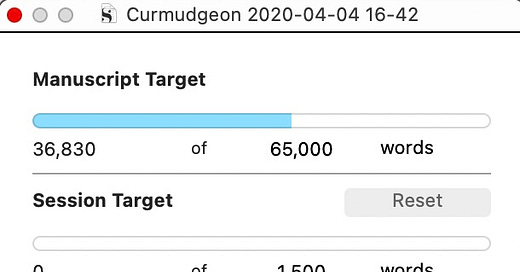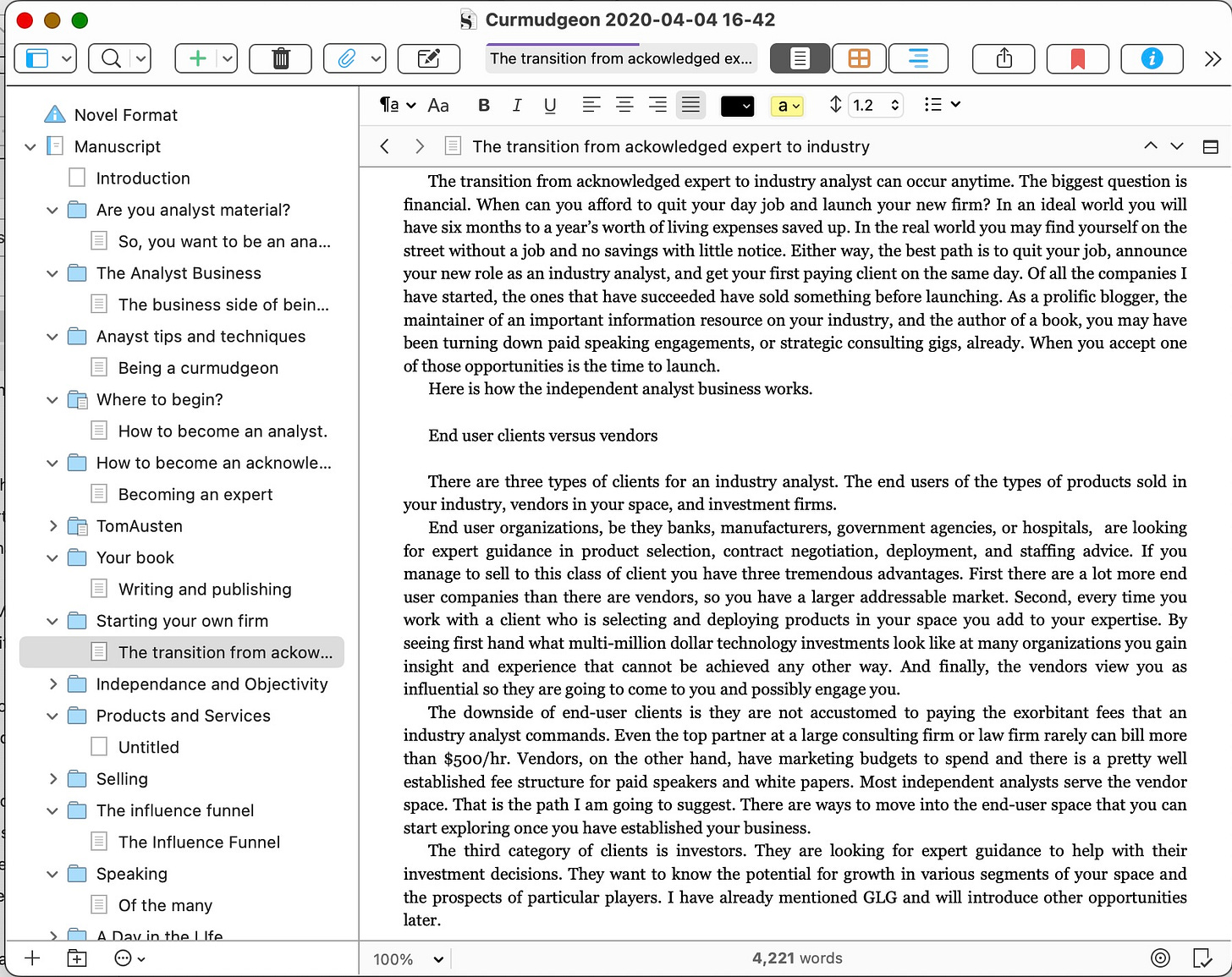Most of this article was originally published on Peerlyst which is now gone. Because I often get questions on writing and publishing, and because I am spending the weekend planning the writing of Security Yearbook 2025 (Wiley, 2025), I thought I would resurrect this from the version that went into Curmudgeon: How To Succeed as an Industry Analyst.
If you are like me, writing a book may never have occurred to you. It is a big time commitment and takes focus over at least a year. I am someone who did not pursue a Master’s degree after college because I was afraid of the requirement to write a thesis. I am a terrible procrastinator and hate doing assigned tasks. As an engineer, writing was never on my list of enjoyable activities. But, while at Webroot Software I started one of the first blogs on security, threatchaos.com, and discovered I love to write. Now, writing is my favorite occupation. After launching IT-Harvest I found myself presenting at a conference in Halifax, Nova Scotia. A documentary producer who was working on a special report on cybercrime asked me if I would sit for a few minutes and be interviewed for his piece. His crew shot me for an hour. When we were done he said “wow, you really know this topic, have you written a book?” That was when it first occurred to me that I should write a book. After several years of blogging I went back and estimated the number of words I had published to-date: over 300,000. A typical book is 75,000 words. I could write a book easily!
After writing Surviving Cyberwar I realized that writing a Master’s thesis was not such a daunting task. I went back to school, wrote that thesis, and turned it into another book (There Will Be Cyberwar.) Along the way I learned something else: there is nothing as satisfying as completing a manuscript and shipping it off to be published. You want to start writing the next book.
Picking a topic
Writing just any book is not good enough. A guide to bicycling across Europe may be the book inside you, but will it further your career? The subject matter has to be relevant to your expertise. It has to build your reputation as an expert on the topic. So think about and research topics and titles. I have found that there are very few books written from an industry analyst's perspective on their own industry. Perhaps a book titled "Getting to know the X industry" would be a good place to start? The advantage to writing on your industry is that your target audience is also your addressable market for the analyst work you will be performing.
Picking a style. There are a few styles you should consider before you start to write. I find the easiest book to write is what I call the ‘extended blog.’ That is pretty much the voice I used for Curmudgeon and I used it successfully in UP and to the RIGHT: Strategy and Tactics of Analyst Influence. I certainly have received much more positive feedback on this style than my first book, Surviving Cyberwar, which was published and marketed as a text book even though it was written to be a New York Times bestseller. Not everything works out as planned. :-) (If you see an emoticon here it is because my editor must have missed it.)
Another style is called narrative non-fiction. This is the best seller style you may be familiar with from Tom Peters or George Gilder or Malcolm Gladwell. Their books are laced with stories of real world people that illustrate their overall theme. Story telling is the most powerful form of human communication and these masters make good use of it.
You could also adopt the style of an extended industry report. While this would be a valuable project, it entails a lot more work, a lot more research, and is probably a longer work.
Start with an outline
Are you familiar with agile programming? I have found that agile techniques are perfect for creating long manuscripts such as books. If you are a member of that species often referred to as "engineers" you will find that you are very comfortable with this approach.
Start with an outline. First just jot down every single topic that should be included. Get 20 or 30 or more on your computer. Then break each topic down into ten or so subtopics. Arrange them in a logical order. There is your outline. Don't write the introduction and the last chapter until you are done writing the first draft.
Set your goal for number of pages. Shoot for 200 pages. That's 50,000 words. Take your 100 or so subtopics and write 500 words on each one (on average). Voila, you have just written a book.
Every book needs a story arc. The first chapter has to pull the reader in and each chapter has to lead to the next. Put the big message, the aha! moment, the climax, in the middle or last third. Tail off by building on that climax, lessons learned, what this all means, etc. Put supporting and reference material in the appendices.
On writing
If you are blogging regularly you are probably pretty comfortable with putting words together into sentences, sentences into paragraphs, paragraphs into chapters. But what about finding the time and place to write? There are lots of good books on writing. Start with the classic On Writing Well. William Zinsser, the author, is a big fan of the breezy style which is how most blog posts are written. Watch the talks and interviews that authors have given on YouTube. You will become fascinated with how other writers write. I once shared a limo with George Gilder and took the opportunity to ask him how he managed to be so productive and his answer was that he wrote every day from 5 to 7 AM. Neil Stephenson rises early and edits the ten pages he wrote the day before. After effectively loading his current progress into memory he is able to scratch out the next ten pages. He claims to stop around 2 PM every day. Of course this reflects the immortal advise from Hemingway: write every day and stop when you know what you are going to write the next day. In this way you overcome the delay and possibly the procrastination that comes from staring at a blank page/screen.
If you can carve out a schedule that allows you to write every day you are better than I am. I need large blocks of time to write, minimum of four hours. Besides, my brain, fingers, and eyes do not even work together until after 10 AM. I retreat to my writing shed or the public library and write a few hours a day for several weeks. Then I schedule a week in a motel with a view of Lake Huron for a major sprint. I can usually write 25,000 words in such a retreat. Part of the reason it works so well is that I have carved out this time to write; I have a target, and I am paying for the luxury of time alone. This pressure makes it easier to shut off Netflix for the duration. I wrote UP and to the RIGHT in five days at a hilltop bed and breakfast near Nashville Tennessee called Butterfly Meadows.
There is a tool you have to use for your writing. I discovered it the day before starting UP and to the RIGHT. I had been dreaming of a word processor that made it easier to write in the chunks that the agile process calls for. I also wanted something that would show a progress bar against a target number of words as I wrote. When I finish a great sprint and am a thousand words short of my goal for the day it helps to see that progress bar turning from yellow to green but not quite there yet. I pick another two topics and get 500 words each written and then I can quite for dinner.
The best tool created yet for writing is called Scrivener. It was created by a programmer in England and is experiencing tremendous success as more and more authors and students discover how powerful it is for long manuscripts. It also makes publishing a snap.
I learned how to use Scrivener in a couple of hours watching YouTube videos. It is available for Mac and PC and only costs $60. Here is a screen shot of what the project for Curmudgeon looks like.
The left hand side shows all the chapters, the appendices, and the front matter (title page, copyright page, dedication). The biggest advantage of Scrivener over Microsoft Word is that chapter organization is so easy. Most books created with Word end up being separate files for each chapter. When you decide to add a chapter or move chapters around (and you will) you have to rename all the files! In Scrivener you just drag the folders up or down and insert new material anywhere. You can also assign word targets to each chapter and there is a project status bar that tracks progress towards your total and there is a daily target that is reset every night at midnight.
There are other useful features to Scrivener. The cork board view mimics the way a lot of authors organize their thoughts into notecards. Another feature is that you can hit the “Compose” button and get rid of all the control panes and just see a blank "sheet of paper" so you can write without distraction. Use Scrivener. You can thank me later.
One final tool that can help. Get yourself an AlphaSmart. This is a clunky plastic keyboard that is just meant for writing a lot of words. It has a four line LCD screen so you can see what you are writing and it runs on rechargeable batteries. You can get 800 hours on a charge, far surpassing the time a laptop provides for writing. The AlphaSmart is for power sprints. Step away from your computer. Find a good place to settle in and get all your thoughts down into words. Don’t worry about spelling or punctuation. Just get your words out of your brain and into the AlphaSmart. When you get back to your computer plug it in via USB cable, open any empty text document and hit “send.” Then take a break as the AlphaSmart re-types your words into the document. Because it is using the standard keyboard protocol to talk to your computer there is no need for any software. It will work with any computer that has a keyboard. Cut and paste the new text into Scrivener and clean it up.
The AlphaSmart seems expensive at $600. I buy them for $25 on eBay. Much of my first and second books were written on my AlphaSmart.
Editing
Now send your draft to your editor. Yes, you need an editor. This is someone who has studied writing and understands the art and science of authorship, be it fiction or non-fiction. He or she will help ensure that your book is readable, transitions from chapter to chapter, and just makes sense. Your editor may be the only person who reads your book cover to cover before it is published.
You may also want to employ a copy editor for catching all those misplaced commas and dangling participles. Also, get someone in your industry to read it with an eye towards fact checking. Save yourself the embarrassment I suffered from getting the address of the National Security Agency wrong in Surviving Cyberwar. A knowledgeable industry person will catch the glaring errors and perhaps give you great feedback on how to improve the book. You will find people are very interested in your project and happy to participate in its success. Early readers may even provide the blurbs for the back cover and write an Amazon review for you.
Publishing
Anyone who has been through the traditional publishing process has horror stories to tell about inept editors, clueless marketing, stupid pricing, and drawn out lead times. But despite all of that, for the purposes of becoming an acknowledged expert it is still best to get published in the traditional manner. There is an onus attached to the self published author that has to be overcome with great writing, content, and marketing. As far as your author reputation is concerned you are done once you publish traditionally. The quality and impact of your book are secondary.
Picking a publisher
When you write fiction you have to submit a completed manuscript to dozens of publishers and often enlist an agent to help you. It is a grueling process and the history of publishing is rife with stories of great authors who were rejected repeatedly.
Non-fiction authors have a much easier path. Most non-fiction publishers will accept submissions of proposals instead of completed manuscripts. Even though I would argue for self publishing, I still recommend going through the proposal submission process with a couple of publishers. It is educational and will help hone your plan for the book. Find the publishers that have published books like yours. Browse a book store if you can find one. Amazon has complete publisher information for every book they sell. Most publishers have submission instructions on their websites. You can even find their acquisition editors on LinkedIn. Send her a brief description about why the world will end if your book is not published and see if they have any interest. Just complying with the long submission forms and cumbersome process of identifying your target audience, the size of that audience, the competitive books already out there is a valuable exercise. One of the publishers may even offer you a contract.
Think about the impact on your career that a book could deliver. If you haven’t yet, start blogging. When the idea for a book hits, go with it! Enjoy the first draft phase, I agree with all the writers who claim that is the best. Just hammering our your thoughts. Often having new ideas as you write. It’s a great feeling.







Thank you so much for sharing these practical pointers, Richard. It inspires me to write more, and get my experiences structured in a way that I have a start and an end point to the entire journey.
Damn this is good! And just what I needed today. Thanks Richard!